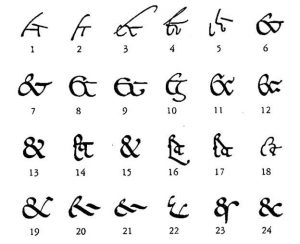Our alphabet has gone through many changes over the centuries. At least 12 letters that used to be welcome there have been ousted. Among those kicked out is the symbol “&,” the ampersand, which means “and.”
The ampersand is a ligature: two or more letters joined together as in the character æ. The ampersand began as a ligature of the Latin letters e and t which spell the Latin word et or “and.”
The symbol has been around since ancient times, but didn’t appear in print until the 15th century. The chart below illustrates the evolution of the ampersand over time. These are just a few examples of the many forms this ligature has been known to inhabit.

Unlike all of the other letters, the ampersand doesn’t represent a sound.
Where did the word ampersand originate?
As the popularity of the & symbol increased, the ampersand gained a place as the 27th letter of the alphabet.
In 18th-century English schools, students were taught to use the phrase per se when reciting the alphabet. Per se meant “by itself,” and was spoken before the letters “A,” “I,” and, for a while, “O,” each of which could stand by itself as a word. So in recitation, students would say “per se A, B, C….per se I, J, K….and so forth.
When the ampersand was added to the alphabet, instead of “X, Y, and Z,” students would recite “X, Y, Z, and per se and,” meaning that the letter & stood by itself at the end of the alphabet.
The phrase “and per se and” eventually turned into (got slurred together as) the word ampersand.
So next time you use the & in a text/tweet/email … may you find joy in knowing where that little symbol came from and how it got its name.
Enjoy!
Some of the sources for this post:
https://medium.com/black-lion-banner/the-history-of-the-ampersand-c81839171940
https://en.wikipedia.org/wiki/Ampersand
https://99design.com/blog/tips/history-of-ampersands-typographyh/
Big fan of the ampersand here! Fun read. 🙂